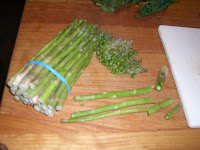 |
| "Magic" Chicken is ready to go into the oven. |
Chicken tenders are so handy and quick
cooking and this recipe, including prep and cooking
time takes just about 20 to 25 minutes. We almost always pound chicken
tenders (creating “cutlets”) to insure that they cook evenly and quickly + the
portion size “seems” to increase as the poultry is flattened.
Rather than the usual breading technique
(involving dipping into wet and dry ingredients), I simple smear the “cutlet”
with mayo and then cover with bread crumbs and bake. It doesn’t get much
easier. And, the side dish, Calico Quinoa, is also an equally quick fix.
Since our original posting, we've added another recipe option -- both are good but we now prefer the revised recipe at the bottom of this post!
"Magic" Chicken -- Original Recipe Ingredients & instructions for 1
serving
1 chicken tender
1 scant tablespoon mayonnaise
(regular, reduced fat or olive-oil based)
About 1 tablespoon dry bread
crumbs with about ½ tsp. Italian seasoning mixed in
Thyme sprigs, optional
1. Preheat oven to
425°.
2. Line a baking sheet
with foil. (You’ll be glad you did when it’s clean up time!)
3. Pound the chicken
tender a couple to times until it flattens and is of an even thickness.
 |
| We put the chicken tender in a plastic bag & then pound it with the bottom of a saucepan. |
4. Position tender on
foil-lined baking sheet; spread with mayo and top with bread crumbs and thyme.
5. Bake 10 to 15
minutes or until chicken in thoroughly cooked.
 |
| Dinner for Two—"Magic" Chicken, Calico Quinoa & Steamed Asparagus are all ready in less than 30 minutes. |
Check out some of our other menus by clicking on the MENUS tab at the top of this page.
Revised Recipe -- Basically the same, but in this version we used Panko and then bake the chicken on a rack which keeps the bottom of the chicken really crisp . . .
"Magic"
Chicken - Revised Recipe Ingredients & instructions for 1 serving
(The amounts below are for 1
chicken tender; when I’m doing this in quantity, I just dump a bunch of mayo in
a pan, a bunch of Panko and oil – I really don’t measure!)
1 scant
tablespoon mayonnaise
About 1
tablespoon Panko with enough olive oil drizzled in to make the crumbs slightly
moist
1
chicken tender
1. Preheat oven to 425°.
2. Line a baking sheet with a cooling rack; spray rack with pan spray.
3. Put mayonnaise in a low, flat container for dipping.
4. Mix Panko with olive oil in a low, flat container for dipping.
5. Immerse chicken tender in mayonnaise to coat, shaking off excess. Then dip
in Panko, coating both sides.
6. Arrange breaded chicken tenders on cooling rack. Ideally they should be
refrigerated for at least a couple of hours (overnight is fine, too) as this
helps coating stick as chicken bakes.
7. Preheat oven to 425°
8. Bake 15 min.+, until bread crumbs are golden brown. (170° internal temp).

























